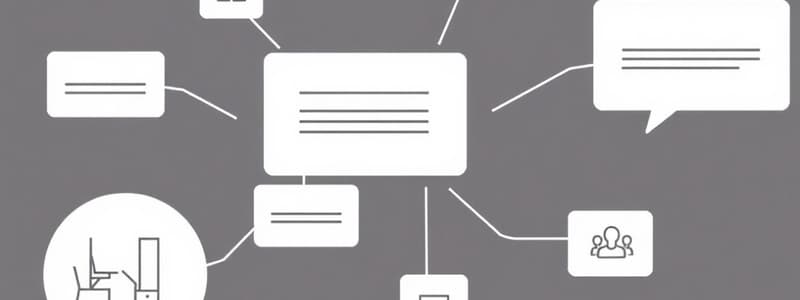Podcast
Questions and Answers
What is the primary purpose of creating a paper prototype of an app?
What is the primary purpose of creating a paper prototype of an app?
- To test initial design assumptions before final development (correct)
- To gather user demographics for marketing purposes
- To develop a marketing strategy for the app
- To finalize the app's appearance and features
What is the role of empathy in the design process?
What is the role of empathy in the design process?
- To enhance marketing strategies for the product.
- To focus solely on the aesthetic appeal of the design.
- To ensure the product's technical specifications are met.
- To pay attention to a user's feelings and needs. (correct)
Which of the following best describes the role of feedback in app development?
Which of the following best describes the role of feedback in app development?
- Feedback is useful only for determining aesthetic choices.
- Feedback should be ignored as it complicates the design process.
- Feedback is only useful after the app has been completed.
- Feedback helps create a plan for further development of the app. (correct)
Which of the following describes usability in design?
Which of the following describes usability in design?
What should be done after analyzing user tests for an app?
What should be done after analyzing user tests for an app?
What aspect does designing the user interface of an app primarily focus on?
What aspect does designing the user interface of an app primarily focus on?
How should user feedback be handled in the design process?
How should user feedback be handled in the design process?
What is a prototype in the context of design?
What is a prototype in the context of design?
Which task occurs when collaborating to create a digital artifact?
Which task occurs when collaborating to create a digital artifact?
What is the purpose of a user profile in design critiques?
What is the purpose of a user profile in design critiques?
Flashcards
Empathy in Design
Empathy in Design
Understanding and considering a user's feelings and needs during the design process.
User Profile
User Profile
A detailed description of a typical user, including their needs, goals, and behaviors.
Usability
Usability
How easy, efficient, and satisfying an object or device is to use.
Prototype
Prototype
Signup and view all the flashcards
User Interface (UI)
User Interface (UI)
Signup and view all the flashcards
User Needs
User Needs
Signup and view all the flashcards
Paper Prototype
Paper Prototype
Signup and view all the flashcards
Target Users
Target Users
Signup and view all the flashcards
User Flow
User Flow
Signup and view all the flashcards
Digital Prototype
Digital Prototype
Signup and view all the flashcards
Study Notes
Design Thinking and User-Centered Design
- Empathy in Design: Focuses on understanding user feelings and needs when creating a product.
- User: Refers to anyone interacting with a product (e.g., software, hardware).
- Usability: Measures how easy, efficient, and satisfying it is to use something.
- Critique & Improvement: Analyzing a design from a user's perspective, recognizing improvements based on a user profile.
Iterative Design Process
- Prototyping: Creating early models of a product for testing and gathering feedback before final development.
- Paper Prototypes: A physical representation used for early design testing, particularly useful for apps.
- User Feedback Collection & Analysis: Gathering and organizing feedback from user testing to refine design and improve the product.
- UI (User Interface) Design: Involves the visual elements of an application that users interact with. Prioritizing feedback is key.
- Generating Strategies: Developing diverse approaches to meet user needs.
- Selecting Strategies: Analyzing strategies to choose the most appropriate ones.
- Interviews: Collecting data to understand user needs in-depth.
Computational Artifact Design
- User Profiles: Defining target users and their needs.
- Target Users: Describing the characteristics of who will interact with the final product.
- Collaboration: Planning and assigning roles for teamwork in the project.
- Roles & Responsibilities: Defining individual tasks in a collaborative project.
- Digital Prototyping: Creating a virtual version of an application's interface for testing and feedback.
- Input Elements: Understanding the correct input elements (e.g., text boxes, buttons, etc.) for data capture.
- User Flows: Mapping the steps through which a user interacts with the application's functions.
Testing & Evaluation
- Identifying Features to Improve/Remove/Add: Analyzing user testing feedback to improve, remove, or add features to an app, based on testing results.
- Detecting & Responding to User Input: Creating a digital prototype that reacts to user actions.
- Analyzing and Prioritizing Feedback: Categorizing and assessing user feedback to prioritize improvements.
- Final Computational Artifact: Bringing together all the design components into a complete digital application.
Studying That Suits You
Use AI to generate personalized quizzes and flashcards to suit your learning preferences.




